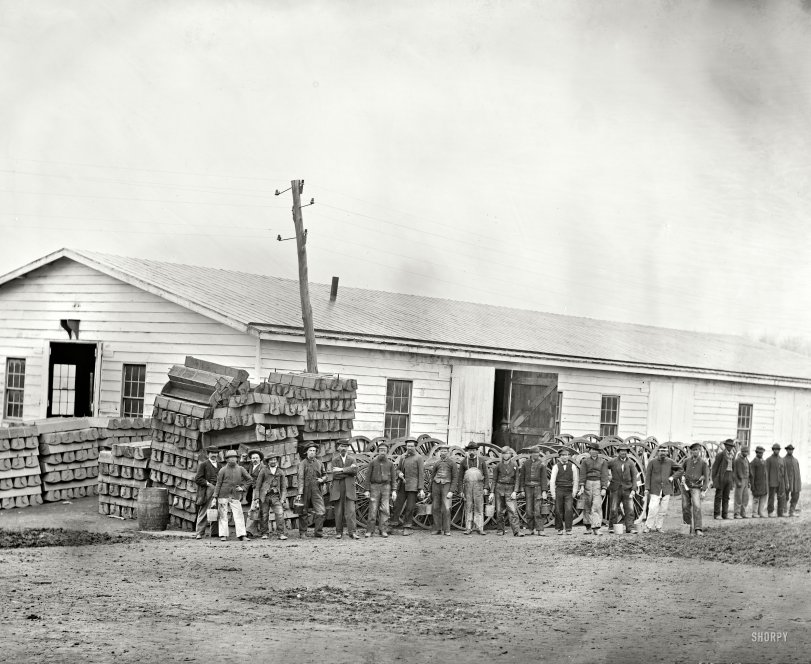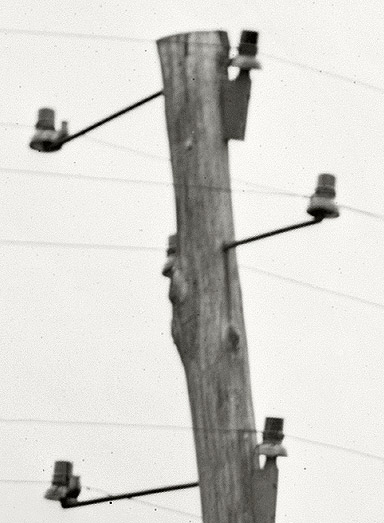


Framed or unframed, desk size to sofa size, printed by us in Arizona and Alabama since 2007. Explore now.
Shorpy is funded by you. Patreon contributors get an ad-free experience.
Learn more.

- Baldwin 62303
- Baldwin VO-1000
- Cold
- No expense spared
- Tough Guys
- Lost in Toyland
- And without gloves
- If I were a blindfolded time traveler
- Smoke Consumer Also Cooks
- Oh that stove!
- Possibly still there?
- What?!?
- $100 Reward
- Freeze Frame
- Texas Flyer wanted
- Just a Year Too Soon
- WWII -- Replacing men with women at the railroad crossing.
- Yes, Icing
- You kids drive me nuts!
- NOT An Easy Job
- I wonder
- Just add window boxes
- Icing Platform?
- Indiana Harbor Belt abides
- Freezing haze
- Corrections (for those who care)
- C&NW at Nelson
- Fallen Flags
- A dangerous job made worse
- Water Stop
Print Emporium
Paint Your Wagon: 1865

April 1865. "District of Columbia. Government repair shops. Paint Shop." Another motley crew from the Civil War era. Wet plate glass negative. View full size.
$50,000 Telegraph Pole
The five insulators on that telegraph pole might be worth $50,000-$100,000 to a collector. They are called "glass teapots" because of the little arm, used to string the line during wartime without using a tie wire (although these are tied). Only a handful have shown up in a 50 year old hobby, certainly no photos of them in use other than this. Incredible.
Insulators aplenty
Thanks for the great photo. All the glass telegraph insulator collectors on ICON (Insulator Collectors On the Net) are going crazy seeing them in use. There are a lot of collectors that specialize in just that kind of insulator.

Viewers Input
Viewers input is part of what makes Shorpy so interesting. The pictures are great to start with but the additional information provided by viewers adds to the history of these photos. Thanks Dave and all fans of Shorpy.
Bucket lust
The coy looking bloke next to the guy with the long white sleeves is holding a "tar bucket." These were filled with heavy grease used for wagon and cannon axles. The rim indicates that it was intended for axle lubrication. I have one that is identical but empty. Originally the bucket in the photo had a very short chain and toggle so it could be carried under a cannon. The one in the photo has wound up in inglorious use as a paint bucket.
Re: Feedbox Depot
Really glad to know the real use for the wooden boxes. I was not even close in my guesses. When folks retired these wagons and horses they could use the boxes for window planters maybe.
Thanks Tobacconist
I was hoping someone would post an explanation of the stacked wooden thingys. I didn't want to ask thus exposing my ignorance to all of Shorpydom.
Feedbox Depot
The stacked troughs are feedboxes. When on the move, they were slung on the wagons with two chains, as shown in the first drawing below.
When stopped for feeding time, the boxes were attached to the tongue of the wagon and the horses were tied to each side. As you can see in the enlarged picture, one side of each box has a pin while the other side has a tab. In the drawing below there is a staple or lug part way down the tongue that holds the tab. The pin goes into the hole for doubletree pin, which has been removed. Simply insert tab (a) into slot (b) and insert pin (c) into hole (d) and the box is ready to be filled with feed.
The top edges were capped with iron strips to keep the horses from eating the wood.
Raggedy Andy
That is one ragged jacket the man 4th from the left is wearing! It looks like it's been nibbled on by rats! The front of his pants might be ripped, too. Good thing he was wearing his black Calvin Klein long-johns in honor of picture day!
Upon closer inspection, he might actually be wearing a full set of decent clothes under the pants and jacket. I suppose you might as well wear old clothes over your good ones if you are going to get paint all over them.
Emancipation
I noticed the African Americans in this picture with great interest. How they are presented in these old photos says a lot about their status at that particular time and place. April of 1865 would have been close to the 3rd anniversary of emancipation in the District of Columbia. In April of 1862, President Abraham Lincoln signed the Compensated Emancipation Act for the release of certain persons held to service or labor in the District of Columbia. The Act freed about 3,100 enslaved persons in the District of Columbia nine months before President Lincoln issued his famous Emancipation Proclamation. The District of Columbia Compensated Emancipation Act represented the only example of compensation by the federal government to former owners of emancipated slaves. Additionally, the District had many free persons even before emancipation. Many of these individuals were highly skilled artisans, working at the Naval Yard and at the various government building projects. But by the end of the war the District was filling up with former slaves from the rebellious states. Many of whom arrived with little more than the clothes on their backs and no marketable skills other than their willingness to work hard. These men, from their dress and demeanor, could possibly be of this later group.
Texture
Notice how different the ground looks with nothing but horse and wagon traffic over it.
Safe!
I guess I'd rather be here painting wagons then out in the field getting my head blowed off!
At the dawn of a new age
Cocksure white men and out-of-focus, diffident-looking black men, as though unsure whether they should be in the picture at all. Black people's emancipation still had some way to go.


























On Shorpy:
Today’s Top 5